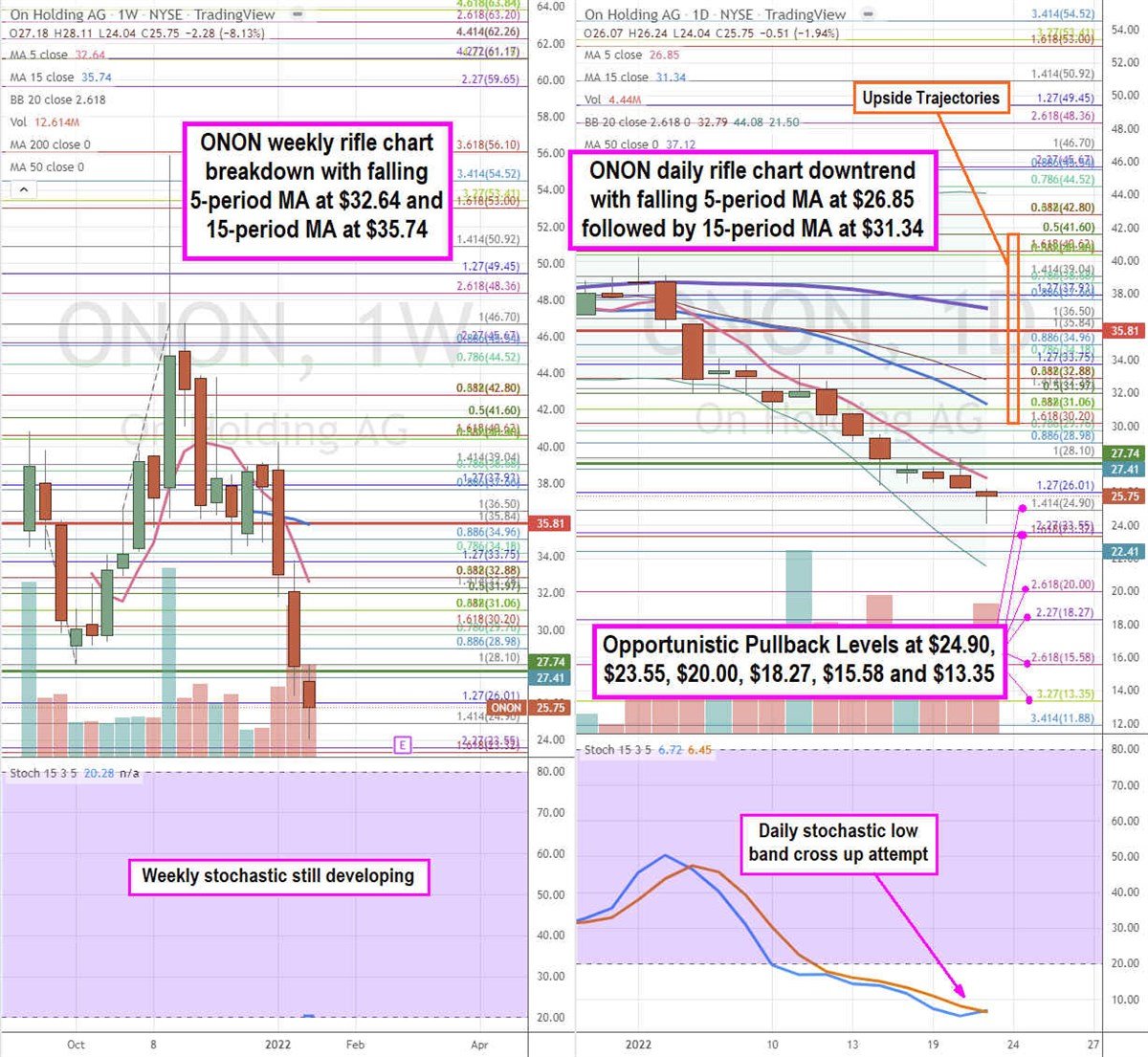Swiss footwear maker
On Holding AG NYSE: ONON stock has been cut in half since hitting highs of $55.87 in November 2021. Ironically, its Q3 2021 earnings represents the strongest quarter in the history of On Holding. The Company IPO’ed in September 2021. The Company announced the development on an
environmentally safer foam called CleanCloud, which is made from using carbon emissions as a raw material. The Company expects
supply chain disruption in the fiscal first half of 2022, but still raised its revenue
guidance for full-year 2022. The Company emphatically states that demand is strong and growing and any shortfalls is a result of
transitory supply issues, not demand issues. Prudent investors seeking exposure in a sports sneaker maker experiencing hyper growth can watch for opportunistic pullback levels in shares of On Holding AG.
Fiscal Q3 2021 Earnings Release
On Nov. 16, 2021, On Holding released its fiscal third-quarter 2021 results for the quarter ended September 2021. The Company reported diluted earnings-per-share (EPS) profit of CHF0.06 beating consensus analyst estimates for a loss on (-CHF0.10) by CHF0.16. Revenues grew 67.6% year-over-year (YOY) to CHF218 million, beating of analyst estimates for CHF182.79 million.
Upside Full-Years Revenue Guidance
On Holding raised its fiscal full-year 2021 revenue guidance to between CHF710 million versus CHF681.49 million with adjusted EBITDA around CHF92 million. The Company also raised its fiscal full-year 2022 revenue guidance to come in between CHF960 million versus CHF898.87 million with adjusted EBITDA around CHF125 million.
Conference Call Takeaways
Co-CEO martin Hoffman set the tone, “The demand for our products accelerated across both the wholesale the direct-to-consumer channel, as well as all regions and all product categories. As Caspar mentioned, we consider our direct-to-consumer and wholesale channel highly complementary. In Q3, we see the strategy being validated by the strong demand in both channels. DTC grew ninety three percent to seventy five point seven million Swiss Frac and wholesale net sales increased by fifty six point seven percent to one hundred and forty two point three million Swiss Frac. Despite the full reopening of retail stores in most key geographies, we see a very strong continued engagement of existing customers and the growth of new customers in our DTC channel. For example, in North America, DTC grew one hundred and twenty nine percent and in Asia Pacific one hundred and fifty two percent. Overall, the contribution of net sales from the direct-to-consumer channel grew to thirty four point seven percent for the quarter versus thirty point two percent in the same period last year.” He continued, “The continued acceleration of the demand in North America it best reflected in the fact that DTC sales crude twice as fast as wholesale. As previously mentioned, we see China is one of the key regional growth driver, which was showcased with strong triple digit sales growth in the third quarter. The Asia Pacific region in total grew by seventy one point four percent with the significant growth in China being somewhat offset by a slowdown in Australia wholesale market as local lockdowns continued into Q3. Also, in Europe, most markets continue to grow strongly with an overall regional growth of fifty point three percent. Here is important to highlight the difference to most other regions, many European market significant COVID restrictions in Q3 2020, which had driven higher wholesale sales in the same period last year. The growth across our distribution network is fueled by the successful expansion and development of our innovation driven products.”
Supply Chain Disruptions
Co-CEO Hoffman concluded, “We expect to have better visibility in the new year on how quickly we can get additional capacity and we will revisit the guidance then. To be very clear again, we are experiencing a transitory supply shortage, not a demand issue. This is not a new situation for over the last decade, strong demand for the on unplanned has regularly outpaced supply. And we have experienced in turning this into an advantage form by tightly controlling distribution to ensure sustainable quality growth. In the first half of 2022, we will face supply shortages on certain products that are higher than what we would like and not all consumers will have the ability to buy exactly the product they are looking. However, we believe in the long run, it will only increase the decidability of the own trend. A tight control of the increase of our SG&A costs in the first half year will allow us to caution mitigate highest rate and distribution expenses.

ONON Opportunistic Pullback Levels
Using the rifle charts on the weekly and daily time frames provides a precision view of the landscape for ONON stock. The weekly rifle chart peaked near the $56.10 Fibonacci (fib) level before sinking into a breakdown with a falling 5-period moving average (MA) resistance at $32.65 followed by the 15-period MA at $35.74. The daily market structure high (MSH) triggered a sell signal on the break of $35.81. The weekly Bollinger Bands (BBs) and stochastic are still developing. The daily rifle chart has been in a downtrend with a falling 5-period MA resistance at $26.85 followed by the 15-period MA at $31.34 and 50-period MA at $37.12. The daily stochastic has been smothered down to the 6-band as it attempts to crossover back up towards the 20-band. The daily lower BBs sit at $21.50. The daily market structure low (MSL) buy triggers above $27.74. Prudent investors can watch for opportunistic pullback levels at the $24.90 fib, $23.55 fib, $20.00 fib, $18.27 fib, $15.58 fib, and the $13.35 fib level. Upside trajectories range from the $30.20 fib up to the $41.60 fib level.
Which stocks are hedge funds and endowments buying in today's market? Enter your email address and we'll send you MarketBeat's list of thirteen stocks that institutional investors are buying now.
Get This Free Report
Like this article? Share it with a colleague.
Link copied to clipboard.